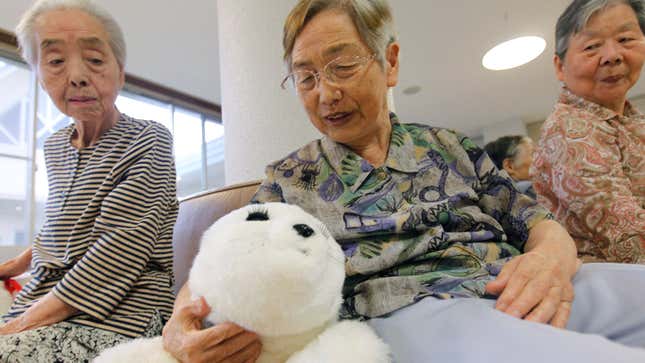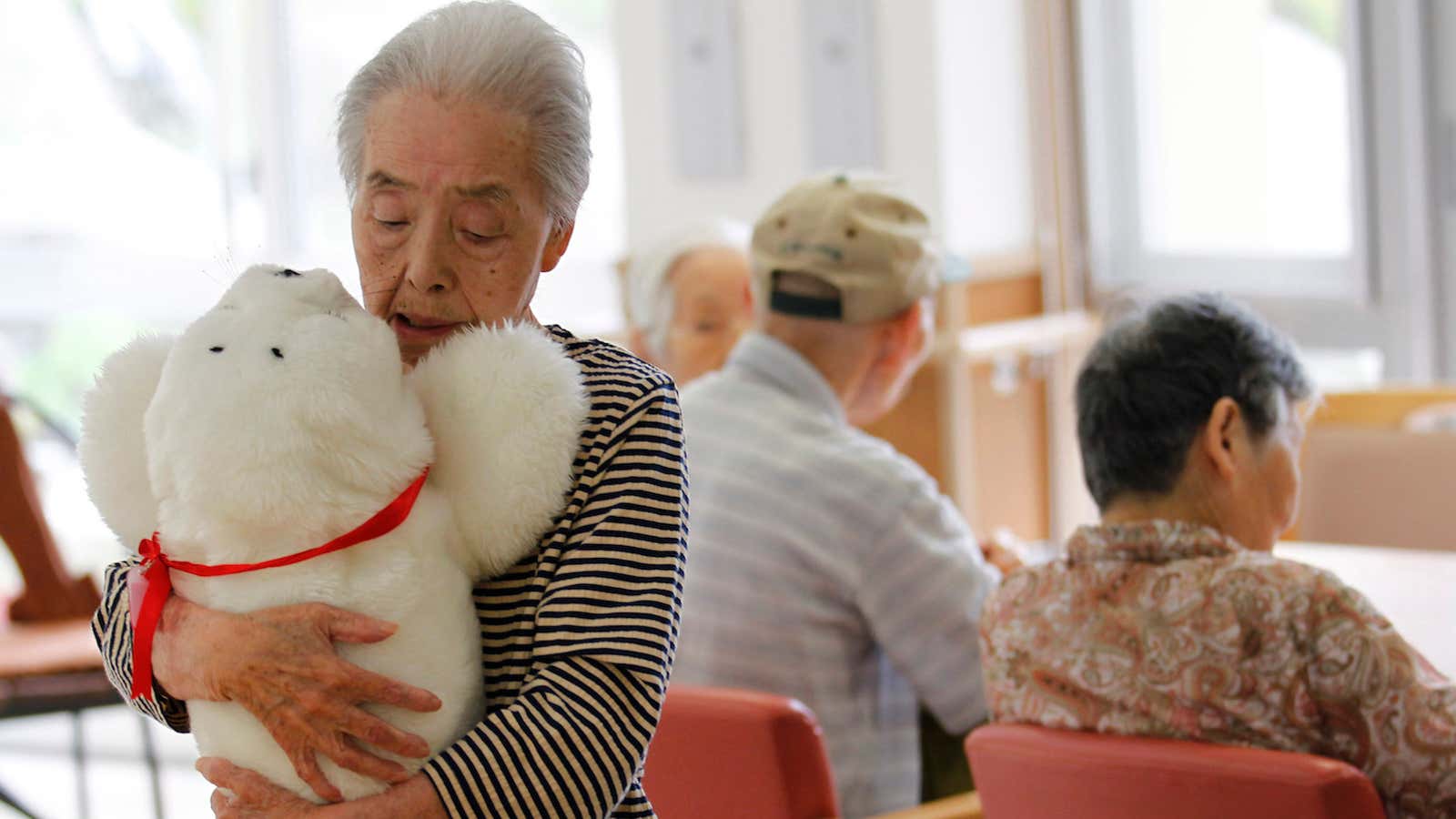This story is part of What Happens Next, our complete guide to understanding the future. Read more predictions about the Future of Aging.
The loneliness statistics among older persons can leave you feeling desolate. Due to the lack of social connection with others, more than 40% of adults over the age of 65 in the US are lonely on a regular basis.
To counteract this phenomenon, we as a society have two options: to outsource social duties to robots, or reconfigure society to care for elders ourselves.
A helping robotic hand… or flipper
Robots will become a normal part of the social and emotional lives of older persons, stepping in with the good intention of alleviating loneliness while providing care and support. They have the potential to become future family members, replacing the ones who are absent.
Such robots will no doubt be readily embraced by the older persons of tomorrow—including yourself. After all, you have already grown used to interacting with early voice assistants such as Apple’s Siri and Amazon’s Alexa. By the time today’s younger generations come of age and technology has caught up with its own hype cycle, it’ll feel totally natural to rely on—and befriend—a social robot in old age.
Take Paro, for example: This robotic baby seal from Japan is a furry endearing companion designed as a therapeutic tool to elicit emotional responses from its users. It imitates the sound of a real baby harp seal and intelligently responds to touch, sound, light, temperature, and posture. It remembers faces and previous action, allowing it to develop its own character over time according to its users’ preferences.

Like a cute living pet, Paro moves its head and makes sounds when being called, maintains eye contact through its adorable big eyes, and can move its flippers when being stroked. Certified by Guinness World Records as the world’s most therapeutic robot, research over the years has found that interactions with Paro reduce stress, stimulate interaction, and improve socialization for both users and their caregivers. There is also evidence of positive physiological effects.
The social roles of robots are sometimes perceived as more important than their practical purposes. A news report on a nursing home piloting “intelligent nursing robots” in China found a surprising result: Although the robots were tasked to provide nursing functions such as checking blood pressure, the residents perceived them more as companions. Some residents even regarded the robots as replacing their children and grandchildren, who rarely visited.
But are we outsourcing empathy?
This all said, being emotionally attached to machines can never fully compensate for the lack of face-to-face presence and one’s desire for human interaction. News reports with titles like “Robots replace family love for China’s lonely elderly” explain this paradox well. When it comes to ethical debates on trusting elderly to the care of robots, we fear the further reduction of regular human contact and feelings of objectification.
But if no one else will be there for the elders, isn’t a robot better than nothing?
Although family will remain important in the future—as the source of emotional closeness, mutual support, and exchanges—the reality is that there will be less of them around to help. As a consequence of mass longevity and prolonged low fertility, future older cohorts will have a higher likelihood of belonging to the so-called “beanpole family structure.” This is where there may be three, four, or even five existing multi-generations, but with less members in each younger generation to care for the older. In the future, there will be fewer grandchildren to go around for a larger amount of grandparents, and grandchildren and their parents may not be living close enough to provide intergenerational support and companionship.
In Japan, “rent-a-family” services have become a business solution to the desire for intergenerational engagement. Japan Efficiency Headquarters, a company that pioneered the business in 1989, was reported to have a waiting list of elderly people who have purchased services to simulate a three-generational family. A typical scenario comprises a visit by actors rented as “family members” to prepare meals and eat together with the elderly couple or individual. They’ll also do family activities together, such as going for a walk in the park, chatting, and have “grandchildren” playing on their laps.
However, the transactional nature of renting a family will only ever solve loneliness temporarily. It will not appeal to those seeking to foster deep and nurturing social and emotional relationships with others. And is that really any better than a robot?
With a lack of real family around to help and robots’ inability to provide real emotional care, we appear to be at an impasse. But there is a solution.
Intergenerational living
We need to revisit the fundamentals of relationship-building in family and community settings. If living in multi-generation family units used to be the norm in small community settings, what new norms can we build in their place?
Intergenerational living situations may be the key to both caring for older persons and keeping the social fabric strong. Bringing the old and young together in the same setting has shown to bring health benefits and reduce social isolation for older persons, as well as reduce ageism and develop empathy in the young.
There are many new forms of intergenerational living communities emerging in different parts of the world. The “homeshare” program in the US, Europe, and Australia matches seniors living alone with college students, who live in their homes for care and companionship in exchange for cheap or free rent.
Similarly, some retirement communities and long-term care facilities invite students to live as their neighbors as a volunteer service. Humanitas in the Netherlands is one such special intergenerational living facility where college students make a lively difference in the life of the older residents. Aside from chatting to the elder residents and helping prepare meals, the students also volunteer as instructors teaching them new everyday essentials, such as using social media, Skyping, and even graffiti art.
Then there is the Intergenerational Learning Center in Seattle, which is a childcare located within an assisted-living community, and Kotoen in Tokyo, which also integrates childcare services with old-age facilities. Both facilities have developed intergenerational programs for more than two decades and have witnessed the positive impact of generational connections among their old and young.
Moving forward, these age-integrated centers will become part of a common social-service landscape. Some governments are already moving in this direction. In its 2015 Action Plan for Successful Aging, the Singapore government plans to develop shared spaces to create more opportunities for intergenerational bonding. They hope that this will promote intergenerational harmony.
These communities are testimonies of our basic desires for intergenerational connections. The opportunities for frequent and spontaneous interactions offered in these settings have enriched the lives of both the old and the young, at the same time contributing toward a caring and inclusive community.
In the future world of technology, the buzz is integration and connectivity. No doubt, robots represent the tech solution of who will care and connect with us—but let’s also consider a better, more humanistic social solution, too.
This story is part of What Happens Next, our complete guide to understanding the future. Read more predictions about the Future of Aging.
